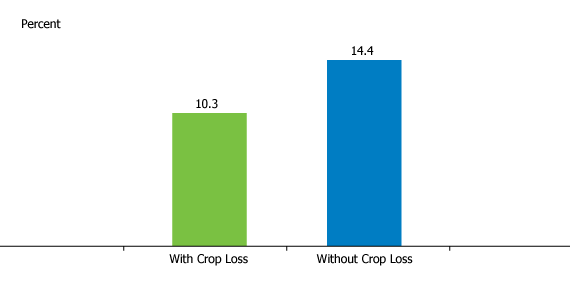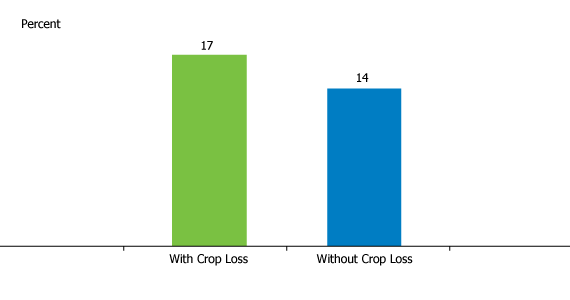
Economic Shock of Crop Loss Increases Contraceptive Use Among Women in Rural Tanzania
Date
June 5, 2013
Author
Children born or conceived during floods, droughts, unemployment, or any other economic hardships are likely to suffer severe malnourishment, or even die resulting from it, according to several studies.1
These children are also less likely to complete primary or secondary education.2 Increasing access to family planning during rough economic times gives couples the option to postpone pregnancies. In my research on Tanzania, I found that rural households increased contraceptive use when provided at an affordable rate, if they lost a significant portion of their crop.3 Couples will choose to delay their next births to a time when their household economic conditions are better. In turn, postponing these births helps reduce malnutrition and mortality among children.
Contraceptives Make a Difference During Economic Hardships
Using the Kagera Health and Development Survey from 1991 to 1994, I examined how economic hardships affect a family’s decisions related to the timing of pregnancies and births. The Kagera region in Tanzania is mostly rural and residents are primarily engaged in agriculture; wage labor is very limited. An unanticipated crop loss can adversely affect a family’s income. I focused on farming households because only these households are likely to be affected by a crop loss; and I classified a household’s economic hardship as a loss of any portion of their crop due to pests or droughts.
My research shows that there were fewer pregnancies in farming households following crop losses. (Previous studies have shown that although conception and birth rates fall in the short term, once the households get over the economic hardship, the rate goes back to the pre-hardship level.) As shown in Figure 1, 10 percent of all women became pregnant after a crop loss, compared to 15 percent among women who did not suffer a crop loss.
Figure 1
Percentage of Women Who Became Pregnant During Crop Loss

Source: Author’s research in Tanzania; and Kagera Health and Development Surveys from 1991-1994.
This decrease in pregnancies is the result of higher contraceptive use following crop losses. Figure 2 shows that 17 percent of women in households use contraceptives following crop loss, compared to 14 percent among women in households that do not face any crop loss. Most households in the areas where the study was conducted can acquire contraceptives for free or at a low cost. Even after accounting for the possible effects of wealth, mother’s age, education, number of prior births, and any characteristics that do not change over time, households suffering a loss of crops in the prior seven months have a 13 percent greater chance of using contraceptives compared to households that did not lose a crop.
Figure 2
Percentage of Women Using Contraceptives During Crop Loss

Source: Author’s research in Tanzania; and Kagera Health and Development Surveys from 1991-1994.
Reasons for Delaying Births
Possible explanations for why women may choose to delay pregnancy during crop loss include:
- Children can be costly in the short-term. Young children do not contribute to household income, but they do require important household resources such as food and clothing.
- An infant takes up a significant amount of a mother’s time. During economic hardships, the mother may need to work even more to recoup a portion of the family income following the loss of crop.
- Households may be aware that children born following an economic hardship are malnourished and less likely to survive.
Ensure Continued Access to Family Planning
Ensuring access to family planning during economic shocks will enable families to delay childbirth to a more favorable time. In turn, this will lead to fewer malnourished children and fewer infant deaths. Although my research is based on data from Tanzania, households in other parts of the world are likely to behave similarly, and ensuring access to family planning is likely to have a similar, beneficial effect.
Shamma Adeeb Alam is a Ph.D. candidate in economics at the University of Washington – Seattle. He was a participant in PRB’s 2012-2013 Policy Communication Fellows Program, funded by USAID through the IDEA project. This article was written as part of the Fellows Program, based on his joint research with Claus Portner of Seattle University.
References
- John Hoddinott and Bill Kinsey, “Child Growth in the Time of Drought,” Oxford Bulletin of Economics and Statistics 63, no. 4 (2001): 409-36; Francisco Ferreira and Norbert Schady, “Aggregate Economic Shocks, Child Schooling, and Child Health,” The World Bank Research Observer 24, no. 2 (2009): 147-81; John Hoddinott, “Shocks and Their Consequences Across and Within Households in Rural Zimbabwe,” Journal of Development Studies 42, no. 2 (2006): 301-21; Harold Alderman, John Hoddinott, and Bill Kinsey, “Long-Term Consequences of Early Childhood Malnutrition,” Oxford Economic Papers, Oxford University Press 58, no. 3 (2006): 450-74; Yuyu Chen and Li-An Zhou, “The Long-Term Health and Economic Consequences of the 1959-1961 Famine in China,” Journal of Health Economics 26, no. 4 (2007): 659-81; and Claus Portner, “Natural Hazard and Child Health,” working paper (2012).
- Ferreira and Schady, “Aggregate Economic Shocks, Child Schooling, and Child Health”; Alderman, Hoddinott, and Kinsey, “Long-Term Consequences of Early Childhood Malnutrition“; and Chen and Zhou, “The Long-Term Health and Economic Consequences of the 1959-1961 Famine in China.”
- Shamma Alam and Claus Portner, “Income Shocks, Contraceptive Use, and Timing of Fertility,” working paper (2012).
